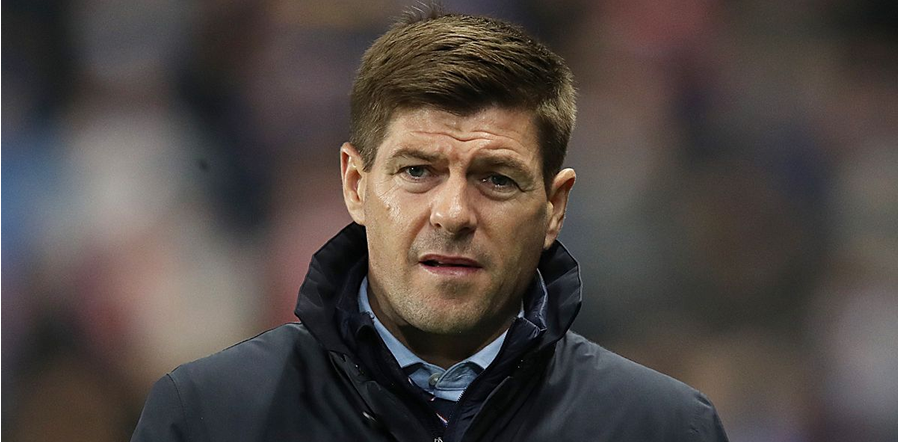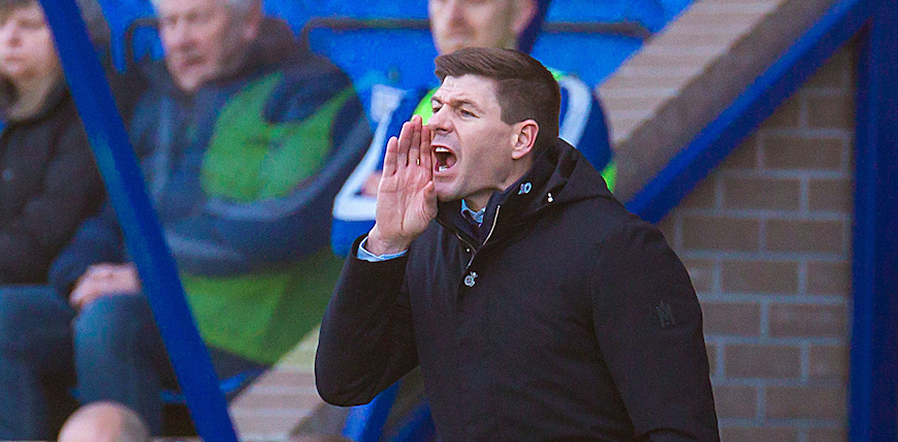There is a weird feeling within the support at the minute, a mix of dread and anxiety with supporters frantically looking for patterns or suggesting ‘rip it up and start again’ tactical plans in a bid to get us back on an even keel.
Rangers have dropped 5 points from their first 5 league games of 2020. It took a full 15 games – a 2-2 draw away to Aberdeen in December – for Rangers to drop more than 5 points during the first half of the season.
What do the numbers say?
That’s a sizeable shift, so I thought it may be worthwhile to look into the underlying numbers behind the results and try to understand in more detail what – if anything – has changed in our on-field play.
I’m going to compare the first 19 games of the season with the last 4. Appreciate the sample size is small in 2020, but there are some interesting outputs.
I’m going to split the analysis into three main parts: defending, passing and attacking
Defending
Hearts away (x2) aside, Rangers have generally been much improved defensively overall this season and the numbers do bear that out.
If we delve deeper into this season and break it down into August-December and then January, we can look to see if there are any reasons for concern.

Lets start with ball recoveries, this is when we press the opposition to win the ball back when they are in possession.
Rangers are winning the ball back more frequently and winning it higher up the pitch than we did in the first half of the season. All good there, that’s a positive increase on last season. It might not look it on the eye, but it’s better.
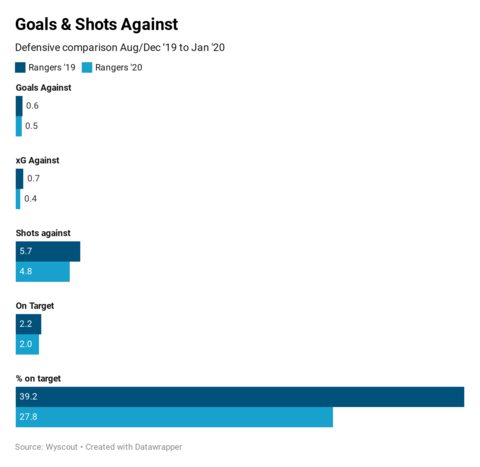
Rangers have conceded slightly less goals on average since the turn of the year. Expected goals against has nearly halved too, suggesting that the defence are doing a very good job at limiting decent goalscoring opportunities for the opposition. This does not consider quality of opposition and the fact that Rangers tend to dominate possession in most games (particularly as 3 of the 4 games were at Ibrox)
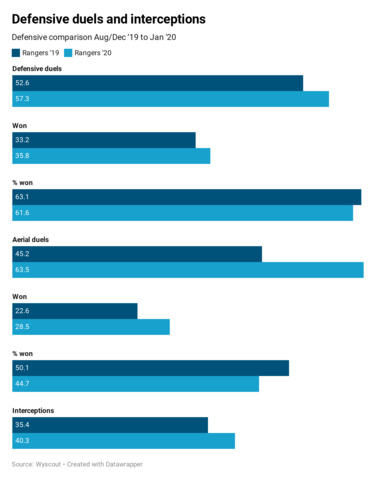
Looking at the shots the Rangers defence have had to contend with, we again see an improvement in 2020. On average, Rangers have conceded one less shot per game and only 27% of these result in Allan McGregor having a save to make.
Again we see a steady increase across more key defensive metrics. Rangers attempt more defensive duels on average and win more. We’ve faced a lot more aerial duels, which is primarily due to the manner in which Hearts & Aberdeen recently played against us. In the Hearts game alone, we faced 89 aerial duels which is nearly three times the average for teams playing against Rangers this season.
Passing
Passing is a catch all terms that get bandied about without the appropriate level of context.
“Player X completes 120 passes in the game with 97% accuracy”
How often do you see that stat and = assume the player had a fantastic match? A look at the more detailed passing metrics – coupled with an understanding of that players specific role within the team – can help to paint a better picture.
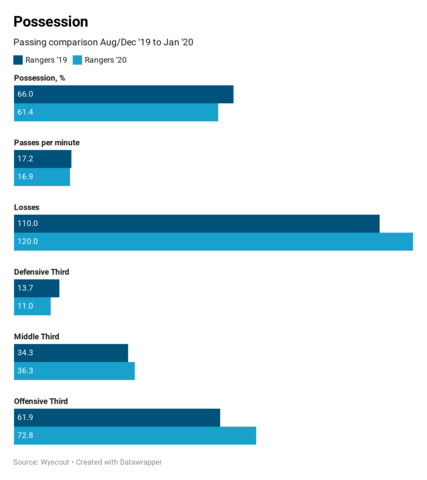
Passes per minute remains consistent which is a decent indicator of the level of tempo the team are trying to play at.
Losses are slightly worrying as the team are losing the ball on average 10 times more per game with the majority of these coming in the final third.

Now we start to see some larger discrepancies between the two sets of numbers. Rangers are making nearly 70 fewer passes per game and the accuracy has dropped from 85% to 80%.
Forward passes have decreased by 10 per game and the accuracy of these forward passes has dropped significantly from 76% to just under 70%.
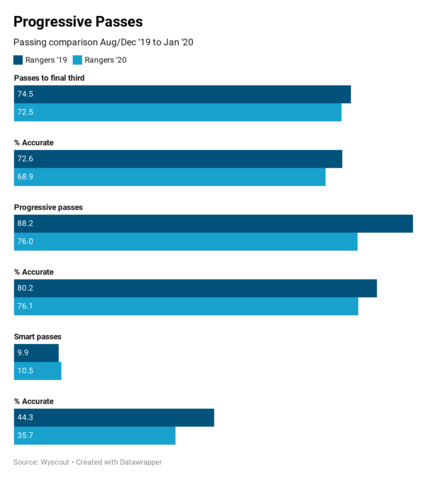
According to Wyscout, progressive passes are defined as forward passes that are 30m long when the pass starts in the team’s own half or at least 10m in length in the opponent’s half.
Pretty much every metric shows a decrease from 2019 which suggests our forward passing in both halves of the pitch needs to improve.
The key term in the definition is ‘at least 10m in length’. Our play in the opponent’s half is predicated on short sharp interplay, therefore this could be a red herring.
For context, James Tavernier has played the third most progressive passes in the league this season and the second highest per 90 minutes (just saying lads). Ryan Jack has the third highest accuracy in progressive passing and attempts the most passes per 90 minutes in the division.

Again, volume & accuracy dips when you start to look at longer passes.
The most striking drop here is in number of deep completed crosses. This has decreased by 66%, the impact of only have one offensively minded full back compared to the usual two.
Long passes have indeed dropped by around 10% which would indicate a quality issue with distribution from defence as mentioned above.
Attacking
Let’s move on to what many believe is one of the main issue at the moment; our attacking play.
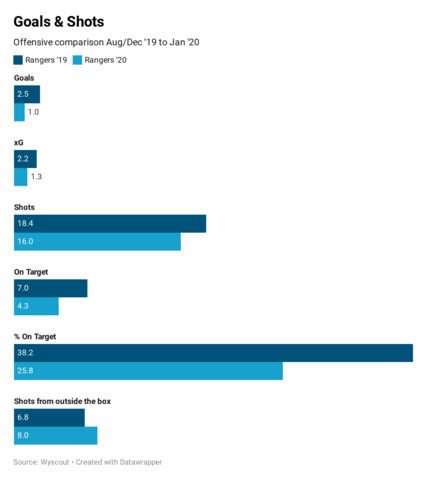
Goals & shots are the juicy stuff and who doesn’t love a bit of expected goals?! Key takeaways here are the number of goals scored and the quality of chances being created. Rangers averaged 2.5 goals per game in the opening 19 league games of the season.
Since the break, Rangers have scored just one goal per game. Expected goals has also decreased sharply which – if you marry with the number of shots taken remaining fairly consistent – tells us that the team are not creating as many high quality chances as they were.

The number of attacks Rangers make has stayed pretty consistent which adds further evidence to a lack of quality in the final third, but the number of shots we have taken in an attacking movement has nearly halved from 8.6 per game in 2019 to 5.3 per game in 2020.

Again, the numbers remain consistent. Rangers are averaging around 37 penalty area entries and approximately 74 offensive duels per game, winning 41% of them.
The number of times the team touches the ball in the box has decreased by 10% in 2020 which is a fairly significant drop also.
By means of a comparison, this season in the league Celtic’s numbers in these 3 metrics are slightly lower than Rangers, which again points to a quality rather than quantity issue.
Conclusion
In conclusion, it looks like Rangers have a number of key issues we can hopefully look to resolve starting with tonight’s game against Hibs at Ibrox.
Defensively we have slightly improved in 2020 – a couple of individual mishaps aside – but we do need to improve our distribution from the back. Teams are aware that Nikola Katic is not the most assured on the ball and are happy to leave him in possession of the ball and sit deep safe in the knowledge he is unlikely to break the lines with a forward pass.
Similarly, both centre backs long passing needs to get back to the standard it was at.
In attack, we are creating opportunities at the same level but our quality has decreased. Basically, we need to create better opportunities.
The most compelling statistics are the drops in goals scored and expected goals. We are creating half as many quality chances as we were in the first half of the season – and unlike earlier in the season we aren’t converting the difficult chances we do create – so the onus is on our creative players to make better use of the ball in advanced areas.

